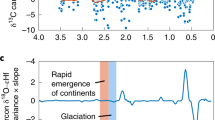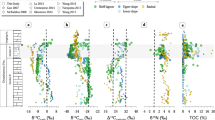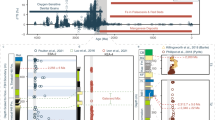Abstract
The hypothesis that the establishment of a permanently oxygenated atmosphere at the Archaean–Proterozoic transition (∼2.5 billion years ago) occurred when oxygen-producing cyanobacteria evolved1 is contradicted by biomarker evidence for their presence in rocks 200 million years older2. To sustain vanishingly low oxygen levels despite near-modern rates of oxygen production from ∼2.7–2.5 billion years ago thus requires that oxygen sinks must have been much larger than they are now. Here we propose that the rise of atmospheric oxygen occurred because the predominant sink for oxygen in the Archaean era—enhanced submarine volcanism—was abruptly and permanently diminished during the Archaean–Proterozoic transition. Observations3,4,5 are consistent with the corollary that subaerial volcanism only became widespread after a major tectonic episode of continental stabilization at the beginning of the Proterozoic. Submarine volcanoes are more reducing than subaerial volcanoes6, so a shift from predominantly submarine to a mix of subaerial and submarine volcanism more similar to that observed today would have reduced the overall sink for oxygen and led to the rise of atmospheric oxygen.
This is a preview of subscription content, access via your institution
Access options
Subscribe to this journal
Receive 51 print issues and online access
$199.00 per year
only $3.90 per issue
Buy this article
- Purchase on Springer Link
- Instant access to full article PDF
Prices may be subject to local taxes which are calculated during checkout



Similar content being viewed by others
References
Kopp, R. E., Kirschvink, J. L., Hillburn, I. A. & Nash, C. Z. The Paleoproterozoic snowball Earth: A climate disaster triggered by the evolution of oxygenic photosynthesis. Proc. Natl Acad. Sci. USA 102, 11131–11136 (2005)
Brocks, J. J., Logan, G. A., Buick, R. & Summons, R. Archean molecular fossils and the early rise of eukaryotes. Science 285, 1033–1036 (1999)
Veizer, J. & Mackenzie, F. T. in Treatise on Geochemistry (eds Holland, H. D. and Turekian, K. K.) 369–407 (Elsevier, Amsterdam, 2004)
Barley, M. E., Bekker, A. & Krapez, B. Late Archean to Early Paleoproterozoic global tectonics, environmental change and the rise of atmospheric oxygen. Earth Planet. Sci. Lett. 238, 156–171 (2005)
Hawkesworth, C. J. & Kemp, A. I. S. Evolution of the continental crust. Nature 443, 811–817 (2006)
Holland, H. D. Volcanic gases, black smokers, and the great oxidation event. Geochim. Cosmochim. Acta 66, 3811–3826 (2002)
Canfield, D. E. The early history of atmospheric oxygen: Homage to Robert M. Garrels. Annu. Rev. Earth Planet. Sci. 33, 1–36 (2005)
Papineau, D., Mojzsis, S. J. & Schmitt, A. K. Multiple sulfur isotopes from Paleoproterozoic Huronian interglacial sediments and the rise of atmospheric oxygen. Earth Planet. Sci. Lett. 255, 188–212 (2007)
Pavlov, A. A. & Kasting, J. F. Mass-independent fractionation of sulfur isotopes in Archean sediments: strong evidence for an anoxic Archean atmosphere. Astrobiology 2, 27–41 (2002)
Zahnle, K. J., Claire, M. W. & Catling, D. C. The loss of mass-independent fractionation in sulfur due to a Palaeoproterozoic collapse of atmospheric methane. Geobiology 4, 271–283 (2006)
Ohmoto, H., Watanabe, Y., Ikemi, H., Poulson, S. R. & Taylor, B. E. Sulphur isotope evidence for an oxic Archaean atmosphere. Nature 442, 908–911 (2006)
Ono, S., Beukes, N. J., Rumble, D. & Fogel, M. L. Early evolution of atmospheric oxygen from multiple-sulfur and carbon isotope records of the 2.9 Ga Mozaan group of the Pongola supergroup, southerm Africa. South Afr. J. Geol. 109, 97–108 (2006)
Barley, M. E., Krapez, B., Groves, D. I. & Kerrich, R. The Late Archaean bonanza: metallogenic and environmental consequences of the interaction between mantle plumes, lithospheric tectonics and global cyclicity. Precambr. Res. 91, 65–90 (1998)
Bjerrum, C. J. & Canfield, D. E. New insights into the burial history of organic carbon on the Early Earth. Geochem. Geophys. Geosyst. 5 doi: 10.1029/2004GC000713 (2004)
Kump, L. R., Barley, M. E. & Kasting, J. F. Rise of atmospheric oxygen and the “upside-down” Archean mantle. Geochem. Geophys. Geosyst. 2 doi: 10.1029/2000GC000114 (2001)
Claire, M. W., Catling, D. C. & Zahnle, K. J. Biogeochemical modelling of the rise in atmospheric oxygen. Geobiology 4, 239–269 (2006)
Li, Z.-X. A. & Lee, C.-T. A. The constancy of upper mantle fO2 through time inferred from V/Sc ratios in basalts. Earth Planet. Sci. Lett. 228, 483–493 (2004)
Hayes, J. M. & Waldbauer, J. R. The carbon cycle and associated redox processes through time. Phil. Trans. R. Soc. Lond. B 361, 931–950 (2006)
Valley, J. W. et al. 4.4 billion years of crustal maturation: oxygen isotope ratios of magmatic zircon. Contrib. Mineral. Petrol. 150, 561–580 (2005)
Sleep, N. H. Evolution of the continental lithosphere. Annu. Rev. Earth Planet. Sci. 33, 369–393 (2005)
Sandiford, M. & McLaren, S. in Evolution and Differentiation of the Continental Crust (eds Brown, M. & Rushmer, T.) 67–91 (Cambridge Univ. Press, Cambridge, 2005)
Bleeker, W. The late Archean record: A puzzle in ca. 35 pieces. Lithos 71, 99–134 (2003)
Condie, K. C. Episodic continental growth and supercontinents: a mantle avalanche connection? Earth Planet. Sci. Lett. 163, 97–108 (1998)
Condie, K. C. in Archean Crustal Evolution (ed. Condie, K. C.) 85–120 (Elsevier, Amsterdam, 1994)
Moores, E. M. Pre-1 Ga (pre-Rodinian) ophiolites: Their tectonic and environmental implications. Geol. Soc. Am. Bull. 114, 80–95 (2002)
Hoffman, P. F. Geological constraints on the origin of the mantle root beneath the Canadian shield. Phil. Trans. R. Soc. Lond. A 551, 523–532 (1990)
Prokoph, A., Ernst, R. E. & Buchan, K. L. Time-series analysis of large igneous provinces: 3500 Ma to present. J. Geol. 112, 1–22 (2004)
Habicht, K. S., Gade, M., Thamdrup, B., Berg, P. & Canfield, D. E. Calibration of sulfate levels in the Archean ocean. Science 298, 2372–2374 (2002)
Kump, L. R. & Seyfried, W. E. Hydrothermal Fe fluxes during the Precambrian: Effect of low oceanic sulfate concentrations and low hydrostatic pressure on the composition of black smokers. Earth Planet. Sci. Lett. 235, 654–662 (2005)
Kharecha, P., Kasting, J. & Siefert, J. A coupled atmosphere-ecosystem model of the early Archean Earth. Geobiology 3, 53–76 (2005)
Acknowledgements
L.R.K. acknowledges support from the NASA Astrobiology Institute and the National Science Foundation. M.E.B.’s contribution was supported by the Australian Research Council.
Author information
Authors and Affiliations
Corresponding author
Ethics declarations
Competing interests
Reprints and permissions information is available at www.nature.com/reprints. The authors declare no competing financial interests.
Supplementary information
Supplementary Tables
The Supplementary Table 1 provides the data used in the assessment of changes in the relative proportion of subaerial vs. submarine volcanism through time based on previously compiled data on occurrences of large igneous provinces. The Supplementary Table 2 provides additional data on older greenstone successions used in our analysis that were not previously identified as associated with large igneous provinces. The Supplementary Table 3 provides a compilation of literature data on the composition of volcanic and hydrothermal fluids and the derived values of “f” used in our analysis of the reducing power of these fluids. The Supplementary Table 4 provides the descriptive statistics and the results of a t-test meant to determine if subaerial and submarine volcanoes have statistically significantly different “f” values. Statistical analysis performed in Microsoft Excel. (PDF 302 kb)
Rights and permissions
About this article
Cite this article
Kump, L., Barley, M. Increased subaerial volcanism and the rise of atmospheric oxygen 2.5 billion years ago. Nature 448, 1033–1036 (2007). https://doi.org/10.1038/nature06058
Received:
Accepted:
Issue Date:
DOI: https://doi.org/10.1038/nature06058
This article is cited by
-
Geodynamic oxidation of Archean terrestrial surfaces
Communications Earth & Environment (2023)
-
Evidence for the oxidation of Earth’s crust from the evolution of manganese minerals
Nature Communications (2022)
-
Oxidative metabolisms catalyzed Earth’s oxygenation
Nature Communications (2022)
-
Earth’s Great Oxidation Event facilitated by the rise of sedimentary phosphorus recycling
Nature Geoscience (2022)
-
Formation of oxidized sulfur-rich magmas in Neoarchaean subduction zones
Nature Geoscience (2022)
Comments
By submitting a comment you agree to abide by our Terms and Community Guidelines. If you find something abusive or that does not comply with our terms or guidelines please flag it as inappropriate.



